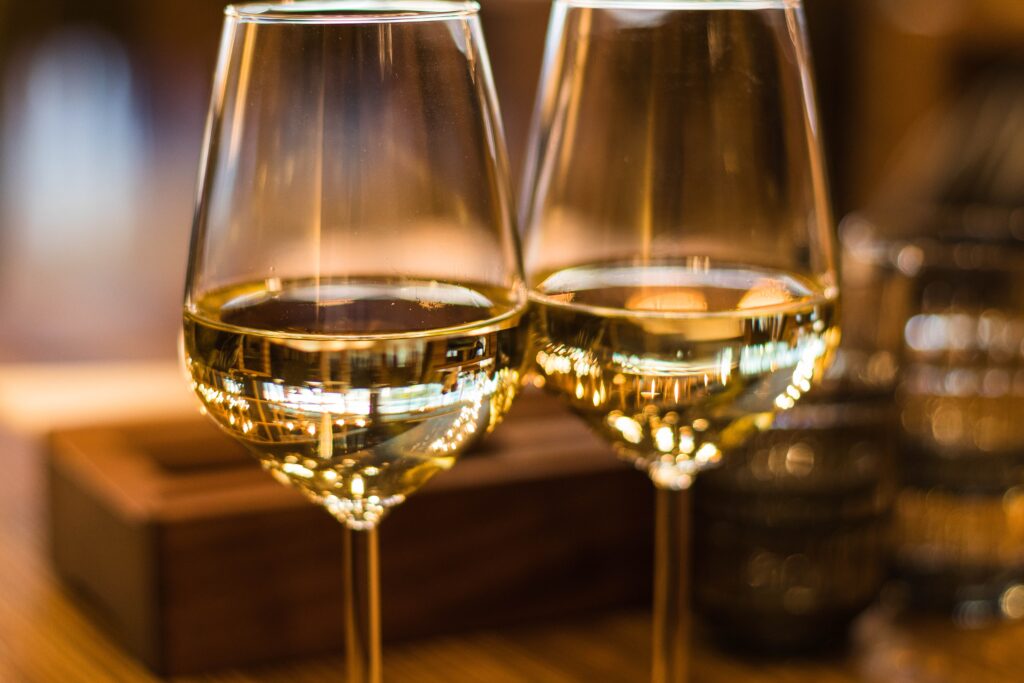Chardonnay at a Glance
Chardonnay is a white wine grape variety native to Burgundy, France. Chardonnay is an important ingredient in the making of sparkling wines. After being confused for the Pinot Noir and Aligote for ages, it was later discovered that Chardonnay comes from crossing Pinot Noir and Gouais Blanc. This explained the continued mistaken identity over time. This is currently the most popular white wine grape variety in the world. You can feel a diverse flavor profile depending on where the grapes come from. It has more flavour if oak had any influence on the wine.
Chardonnay is generally known to be a relatively dry, medium-bodied white wine emanating fresh, crisp notes of pear, guava, lemon-peel and apple. When oak is added to the aging process, the above flavors change so much, giving off strong hints of butter, vanilla, English pudding and pineapple. Most wine enthusiasts will lean one way or the other with Chardonnay; oaked or unoaked.
Climate and Terroir for Chardonnay
One of the oldest Chardonnay growing regions is Chablis, France. Climates similar to that of Chablis are predominantly cool. Giving Chardonnay wine a distinctly leaner feel. These lighter-bodied chardonnays are every so often accompanied by notes of pear, green apple, melon and apricot.
In contrast, Chardonnay grown in warmer regions around the world, such as California’s Central Coast AVA, tend to emit brighter tropical fruit notes; along the lines of guava, peach, pineapple and banana.
France
The world’s most well-regarded Chardonnays come from Burgundy. This region is in Eastern France which also produces expensive, prestigious Pinot Noirs known simply as “Burgundy.” Here, Chardonnays go by many names because they’re labeled by geography, not by grape.
Chardonnay also grows in Champagne, in the northeast of the country. Here, winemakers blend it with Pinot Noir and Pinot Meunier to make the area’s titular bubbles. Most Champagnes are dry and medium-bodied with low alcohol. Sweetness levels vary by dosage, or the amount of sugar winemakers add during vinification. The typical flavors of Champagne are yeasty citrus—buttered brioche, say, or croissants with lemon compote.
Italy
Alto Adige is Italy’s first DOC Chardonnay region. Here, Chardonnays are medium-bodied and balanced. You can feel notes of melon, stone fruit, and bread alongside citrusy tang. Italian Chardonnay finds its way into spumante wines in Lombardia, Friuli, and Trentino; and oakier Italian Chardonnays typically come from Puglia. Tuscany and cooler parts of Piemonte produce crisp, even-keeled Chardonnays.
South Africa
Production is in the Coastal Region, namely Stellenbosch and Constantia. Styles range from fresh, young, fruity wines to some serious oaked, complex examples. The youthful chardonnays are blended, frequently with viognier, to produce a lively, peach-flavored wine with little or no oak.
USA

Most Chardonnays in the United States come from Northern California, specifically Sonoma, Napa, Russian River, and Carneros. Being a cool climate variety, Chardonnay tends to lose its acidity, becoming flabby and often unappealing when planted in warm climates. But it does surprisingly well in California.
Chile
Winemakers have sought out their coolest sites to ensure Chilean chardonnays are filled with concentration and freshness. In the north are the cool Elqui and Limarí Valleys. The limestone-rich soil produces a refined, understated style of chardonnay with vibrant, citrus fruit and mineral-laden aromas and flavours.
Argentina
Many Americans associate Mendoza with Malbec, but Argentina’s high-elevation wine region also produces rich Chardonnays with tropical fruit and citrus flavors. The cooler climate provides balanced acidity, and many winemakers age their Chardonnays in oak, giving them spicy notes.
Australia
Many Australian winemakers have recently started producing quality Chardonnays in cooler-climate regions like Yarra Valley, Adelaide Hills, Mornington Peninsula, as well as the moderate Margaret River. These regions are now the newfound inspirations for crisp, balanced, Chablis-style Chardonnays. Tasmanian Chardonnays are also widely available and feature fruitier flavors balanced with citrus.
New Zealand
Although Sauvignon Blanc comprises of more than fifty percent of New Zealand’s wine industry, winemakers from Nelson and Hawke’s Bay in the North, to Marlborough and Central Otaga in the South are now making diverse styles of Chardonnay. In the Northern regions, lots of sunlight and warmer temperatures mean fruity, fuller-bodied wines. Cooler temperatures in Marlborough produce leaner, more acidic wines.
Chardonnay has fruity flavours and a number of different types or styles, depending on the wine-making process. This makes it a meal companion since you can pair the wine with different foods, to match the occasion.
Young, unoaked, cool climate chardonnay
These are perfect with light and delicate food such as raw and lightly cooked shellfish or grilled fish. They also go well with pasta or risotto with spring vegetables and creamy vegetable soups. Finer, more intense examples such as Puligny-Montrachet can take on raw fish such as sashimi or delicately spiced fish or salads. Chablis is particularly good with oysters.
Full-bodied, oak-aged Chardonnays
These include those that are: barrel-fermented, barrel-aged or ‘reserve’ chardonnays. Particularly top end Australian, New Zealand and Californian Chardonnay. Top white burgundy, served within 1-3 years of purchase.
Similar dishes to the above but can take an extra degree of richness. Fine rich fish, mushrooms, vegetables such as red peppers, corn, butternut squash and pumpkin. Cheddar cheese, if you’re looking for a chardonnay cheese pairing. You can even drink a rich chardonnay with seared foie gras.
Mature barrel fermented Chardonnays
These can be wines that are about 3-8 years old. With age, Chardonnay acquires a creamy, sometimes nutty taste, and creamy texture that calls for a return to more delicate dishes.
In conclusion, Chardonnay is a wine of character. The wine does not have a distinctive aroma or flavour. However, it does have a broad and structured palate. It is a grape distinctive in taste to where it is grown, and how it was treated to get the end product.


